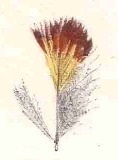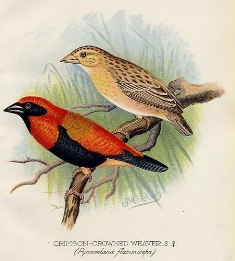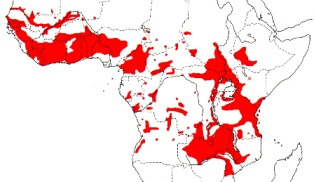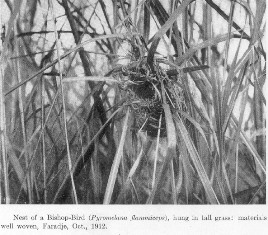Weaver Wednesday [58]: Black-winged Bishop 2013-07-24 (394)
 Weaver Wednesday
Weaver Wednesday


The Black-winged Bishop (or Fire-crowned Bishop) Euplectes hordeaceus is wide-spread through tropical Africa. It is one of 5 'red bishop' species (where the males in breeding plumage are mainly red and black): Northern E. franciscanus, Southern E. orix, Zanzibar Red Bishops E. nigroventris, and Black Bishop E. gierowii. The Black-winged Bishop male in breeding plumage is distinguished from the other 'red bishops' by having both a red crown and red breast band. Females and non-breeding birds are dull coloured, with a broad yellowish supercilium, and a rich brown breast-band. In flight, the black wings (retained in the non-breeding season) contrast with the brown upperparts (the wings are brown in the other 'red bishops').
This species was described by Linnaeus, based on a specimen from Senegal, and photos of the holotype may be viewed here.

The Black-winged Bishop is found from Mauritania in West Africa across to Ethiopia and south to Angola and north-eastern Zimbabwe (see red on map left, based on Birds of Africa). It occurs on Sao Tome (possibly introduced), Zanzibar and Pemba Islands. Several subspecies have been proposed but plumage differences appear to be individual variation and the species is thus treated as monotypic.
The Black-winged Bishop inhabits bushed grassland, rice fields, and tall grassland, as well as open areas in forested country. It is usually in pairs or small groups but forms large roving flocks in the non-breeding season, and is often found in mixed-species flocks.
Its diet is grass seeds, and also rice and green maize. Insects include caterpillars and termite alates. The Black-winged Bishop spends much time near the tops of tall grasses, but forages mainly on the ground in savanna, often concentrated at sites of abandoned cultivation, with secondary growth of tall grasses.

The Black-winged Bishop is polygynous, and the highly territorial males attract up to 4 females. In display, the male perches prominently in his territory with plumage fluffed out. He swivels about, calling constantly, and flies up 4-5 m then glides back to his perch. Males also perform a horizontal display flight between perches with the body feathers puffed out, and wings flapping slowly.
The nest resembles the nest of the Southern Red Bishop but has a larger side entrance and distinct overhanging porch. The nest is placed in tall grass or coarse vegetation, 0.8-3.0m above ground. It is usually supported by grass stems on either side of the large entrance. During droughts, the first nests are built 3 weeks later than average, and more nests are built in trees than in grass. This species seldom breeds in colonies, and is often solitary or with 2 males close together. The male constructs the nest, and may work on more than one at a time. The female lines an accepted nest with fine grass. Only the female incubates the eggs and feeds the chicks. Nests may be parasitized by the Diederik Cuckoo Chrysococcyx caprius.
The Black-winged Bishop has no PHOWN records yet - be the first to submit a record for this species (see PHOWN summary). Old nests may be used by Zebra Waxbills Amandava subflava, so look at old nests too. Submit any weaver nest records to PHOWN (PHOtos of Weaver Nests) via the Virtual Museum upload site.
PHOWN summary
Previous Wedn: Loanga Weaver
Full weaver species list
| 

 Weaver Watch
Weaver Watch


